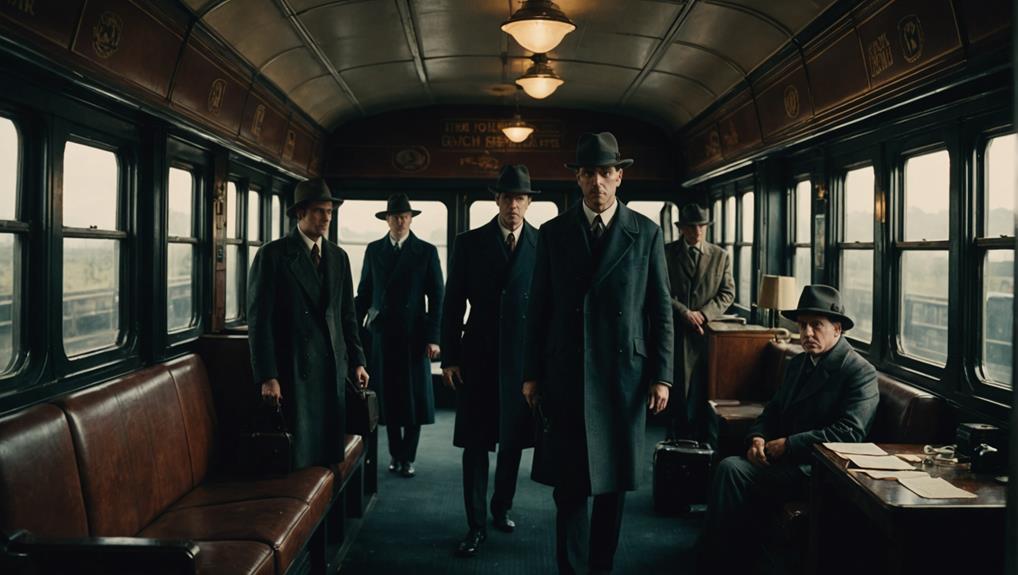Plunge into the classic whodunit 'Murder on the Orient Express' where Detective Hercule Poirot unravels a web of secrecy and deceit aboard a lavish train. The passengers, tied to a chilling murder, craft a collective scheme against the victim, leading to an unconventional twist in the resolution. As the mystery unfolds, themes of justice, revenge, and hidden truths come to light, leaving a lasting impact. Discover the enduring influence of Agatha Christie's storytelling brilliance through this iconic tale, reimagined in Kenneth Branagh's 2017 adaptation for a modern audience. Unravel the intricate layers of suspense and morality in this timeless mystery.
Key Ideas and Setting Overview
Discover the captivating premise of 'Murder on the Orient Express' as it unfolds aboard a luxurious train traveling from Istanbul, setting the stage for a thrilling murder mystery with detective Hercule Poirot at the center.
Agatha Christie's classic novel introduces Poirot to the readers as he navigates through a web of deception and intrigue surrounding the murder of Samuel Ratchett. As the detective investigates the case, he uncovers a complex puzzle involving passengers with connections to the infamous Daisy Armstrong case, adding layers of mystery and suspense to the investigation.
Throughout the story, Poirot's sharp investigative skills are put to the test as he seeks to unravel the truth behind Ratchett's murder. The passengers aboard the Orient Express become both suspects and allies in Poirot's quest for justice.
As the detective uncovers the collective effort behind the murder, he presents two unique solutions to the case, ultimately choosing a path that challenges traditional notions of justice and morality.
'Murder on the Orient Express' isn't just a mystery to be solved but a thought-provoking exploration of ethics and retribution.
Investigation and Suspects
During the investigation of the murder on the Orient Express, Detective Hercule Poirot uncovers a web of suspects with connections to the infamous Daisy Armstrong case. Poirot meticulously interviews passengers, piecing together their backgrounds and motives. The suspects aboard the train become entangled in a complex tapestry of intertwined relationships and hidden agendas, all leading back to the tragic events surrounding Daisy Armstrong.
Each passenger harbors reasons for seeking retribution against the victim, Samuel Ratchett, also known as Cassetti. Their shared desire for justice culminates in a collective scheme to bring about his demise. As Poirot explores deeper into the mystery, he unravels the intricate threads that bind the passengers together in this elaborate crime.
Ultimately, Poirot must navigate the delicate balance between presenting a version of the case acceptable to the authorities and revealing the true extent of the passengers' involvement in the murder.
The varied personalities and conflicting interests of individuals like Princess Dragomiroff and Colonel Arbuthnot add layers of complexity to Poirot's investigation of the murder on the Orient Express.
Collective Crime Scheme

You'll discover how the passengers on the Orient Express come together in a collective justice scheme to enact their plan of revenge against Samuel Ratchett.
Each passenger plays an essential role in coordinating alibis and hiding their collaborative involvement, making it challenging for Hercule Poirot to unravel the truth.
The hidden dynamics of their joint effort shed light on the complexities of seeking justice through a shared criminal act.
Collective Justice Scheme
The Collective Justice Scheme portrayed in Murder on the Orient Express demonstrates a unique approach to seeking retribution through collective action. Hercule Poirot unravels the intricate web of the passengers' collective murder scheme, revealing their shared desire for justice and retribution in the face of moral ambiguity.
The passengers' actions challenge conventional notions of morality and justice, blurring the lines between right and wrong.
- The passengers' collective crime reflects a deep sense of justice and common purpose, evoking empathy for their plight.
- The murder scheme highlights the complexities of seeking retribution as a group, stirring conflicting emotions in the audience.
- The blurred morality surrounding the passengers' actions prompts introspection on the nature of justice and the lengths one may go to achieve it.
In Murder on the Orient Express, the passengers' pursuit of collective justice creates a gripping tale that explores the depths of human morality and the quest for retribution.
Coordinated Alibi Efforts
Passengers aboard the Orient Express collaborate in crafting alibis and manipulating evidence to shield their collective involvement in Ratchett's murder. This coordinated effort stems from a shared desire to seek justice for the tragic Daisy Armstrong case. Princess Dragomiroff, Count Andrenyi, and Colonel Arbuthnot are among those who work together to establish false narratives that protect each other.
Hercule Poirot, though understanding their intentions, grapples with the ethical dilemma presented by their actions. While the passengers make certain that no individual can be identified as the sole killer, their manipulation of evidence showcases the intricacies of collective crime schemes in mysteries.
The murder on the Orient Express ultimately unfolds as a result of the passengers' intertwined motives for retribution, painting a complex picture of justice and moral ambiguity in the face of a heinous crime.
Hidden Collaborative Involvement
Amidst the intricate web of deceit and shared motives aboard the Orient Express, a hidden collaborative involvement emerges, shaping the course of retribution in 'Murder on the Orient Express.' The passengers on the train orchestrated a collective crime scheme to execute the murder of Samuel Ratchett, also known as Cassetti, in a bid to seek justice for the tragic Daisy Armstrong case.
This shared responsibility for Ratchett's murder showcased the deep-rooted emotions and determination of the passengers to right a grievous wrong, even if it meant resorting to extreme measures.
The manipulation of evidence by the passengers to protect each other tugs at the audience's sense of loyalty and sacrifice.
The creation of alibis to shield the true killer evokes a sense of desperation and unity among the passengers.
The collaborative crime scheme highlights the moral dilemma between seeking retribution and upholding the law, leaving a lingering question of what justifies such drastic actions in the pursuit of justice.
Unconventional Resolution
In an unexpected turn of events, the murder case on the Orient Express is resolved through a collective act of justice by the passengers. Poirot presents two solutions: the official version and the true version, where passengers collectively conspired to murder Ratchett for justice.
This unconventional resolution sees the passengers working together to achieve their goal, ensuring no individual can be identified as the killer. While Poirot respects the passengers' intentions, he can't condone their actions in seeking retribution.
Ultimately, Poirot decides to protect the passengers from legal consequences by keeping the truth of their involvement hidden from authorities. This resolution challenges traditional crime-solving methods, highlighting the complexities of morality and justice in a situation where the line between right and wrong is blurred.
The passengers' collaborative involvement showcases a unique approach to addressing a crime that defies the norms of conventional detective work.
Aftermath and Closure

Now that the case is officially closed, the passengers are no longer under suspicion.
Poirot, M. Bouc, and Dr. Constantine choose to keep the truth hidden, protecting the passengers from potential legal consequences.
The journey on the Orient Express continues, but the lingering secrets of the murder cast a shadow over the passengers' collective desire for justice.
Case Resolution Aftermath
Following the conclusion of the investigation, the aftermath of the case resolution on the Orient Express brings closure to the passengers involved. The official version is accepted, clearing the passengers of suspicion.
Poirot, M. Bouc, and Dr. Constantine decide to keep the truth to themselves, choosing to protect the passengers from the law. The case is closed, allowing the train to continue its journey uninterrupted.
The resolution underscores the collective involvement of the passengers in the murder, forming a bond among them that transcends the harrowing events they experienced together. As the Orient Express moves forward, a sense of relief washes over the passengers, knowing that the truth is safeguarded and that they can put this dark chapter behind them.
The shared experience on the train creates a unique connection among the passengers, forged in the crucible of a mystery that tested their mettle and brought them together in unexpected ways.
Concealed Truth Handling
The handling of the hidden truth after the case resolution on the Orient Express guarantees that the passengers' secret remains safeguarded. Poirot, understanding the passengers' motive for the murder as a quest for justice, decides to conceal their collective crime. He presents the authorities with an official version of events that absolves the passengers of any suspicion, allowing them to escape scrutiny. By keeping the true version hidden, Poirot ensures that the passengers' involvement in the murder remains undisclosed.
Despite the seriousness of the crime committed on the train, Poirot, M. Bouc, and Dr. Constantine choose to uphold the passengers' secret, maintaining their pact of silence. The train continues its journey, carrying with it the hidden truth of the murder that only a select few know. The passengers can breathe a sigh of relief as the authorities accept the official version presented to them, closing the case without further investigation into their involvement.
Agatha Christie's Influence
Agatha Christie's impact on the mystery genre remains enduring and profound, shaping the way detective fiction is approached and enjoyed by readers worldwide. Her creation of the iconic detective Hercule Poirot in 'The Mysterious Affair at Styles' set a benchmark for future sleuth characters. 'Murder on the Orient Express,' a classic mystery novel by Christie, stands as a tribute to her unmatched storytelling skills.
Here are three ways in which Agatha Christie's influence continues to captivate audiences:
- Christie's complex plots keep readers on the edge of their seats, guessing until the very end.
- The depth of her characters, especially the brilliant but eccentric Poirot, adds layers of intrigue to her mysteries.
- Christie's ability to craft a compelling murder mystery while incorporating elements of psychology and human nature sets her apart as a master of the genre.
Through her works, Christie has left an indelible mark on detective fiction, inspiring countless authors and filmmakers to explore the enigmatic world of crime-solving.
Film Adaptation and Themes

Kenneth Branagh's 2017 film adaptation of 'Murder on the Orient Express' reimagines Agatha Christie's classic mystery with a modern twist, exploring themes of justice and morality within a luxurious train setting.
Branagh, who directed and starred in the film, introduces modern elements to the story while staying true to the essence of Christie's intricate plot. The adaptation explores questions of retribution and morality as Hercule Poirot, portrayed with a dramatic flair by Branagh, unravels the mystery amidst a diverse cast of characters.
The film aims to captivate both existing fans and new audiences by blending traditional whodunit elements with fresh character dynamics and action sequences. Through this adaptation, Branagh brings a contemporary edge to the timeless tale, infusing it with a sense of urgency and suspense that resonates with modern viewers while honoring the legacy of Agatha Christie's beloved work.
Conclusion
As you close the final chapter of 'Murder on the Orient Express,' you can't help but marvel at Agatha Christie's timeless ability to keep you guessing until the very end.
With its intricate plot and memorable characters, this classic whodunit continues to captivate audiences, even in today's fast-paced world.
So grab your magnifying glass, hop on the train, and get ready to solve the mystery of who dun it – it's a ride you won't want to miss!



